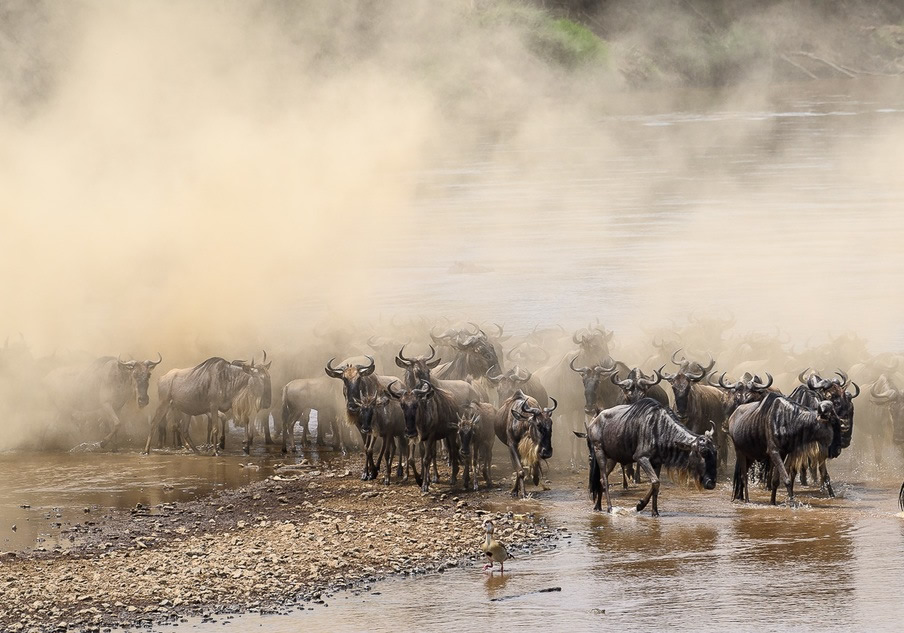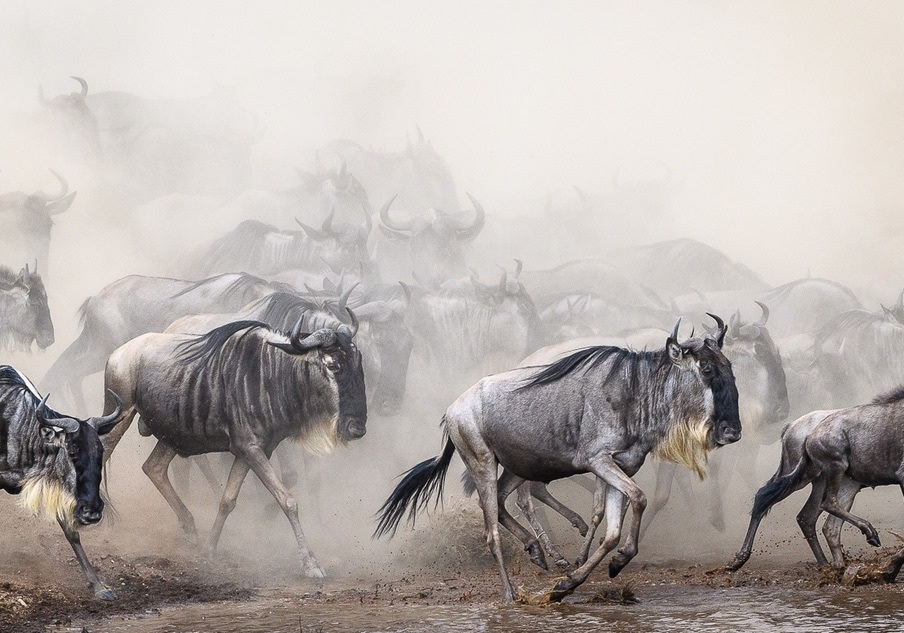The Mara Wildebeest Migration
The Migration is one of nature’s greatest paradoxes: timing is absolutely vital, but there is no way to predict the timing of the animals’ movements. We know that the wildebeest (and a smattering of zebra and antelope) will cross the Mara River – but nobody knows exactly when. We also know that rain will trigger the wildebeest to move onto fresh grazing – but nobody knows exactly when the rain will fall.
Between the months of July and October, one and a half million wildebeest accompanied by vast numbers of zebra and gazelles, make the long and dangerous trek from Tanzania’s Serengeti, northwards towards this corner of Kenya.
Lines of animals stretch as far as the eye can see across the open plains. They come to give birth to their young and the grasslands echo with the sounds of the new-born. It is a time of plenty. But it is a time too, when the predators are drawn from all around; high above on the hot winds, the carrion birds, vultures and eagles soar. In the long grasses lion, cheetah, leopard and hyena prowl.
Most dramatic of all is the moment when the migration arrives at the Mara River; they must cross it to reach the rich grazing areas on the other side. It takes the bravest to plunge first into the swirling currents and thousands follow. Meanwhile, keen crocodiles cruise the waters.

Wildebeest Migration
January, February and March
Around January each year, the migration will be finishing a southwards trek, moving along the eastern edge of the Serengeti and into the Ngorongoro Conservation Area. Here the plains are rich in nutritious grass, providing the herds with the best conditions for raising their newborn calves.
Although there is no real beginning or end to this migratory circuit – other than birth and death – it seems reasonable to call the wildebeests’ birthing season the start of the migration. Around late-January or February, the herds occupy the short-grass plains that spread over the lower northern slopes of the Ngorongoro Crater highlands and around Olduvai Gorge. Some 400,000 calves are born here within a period of two to three weeks - some 8,000 new calves every day.
The abundance of vulnerable young calves means the surrounding predators also spring into action, hunting with ease due to the sheer numbers of wildebeest.
April and May
After bearing their young in February and March, around April the wildebeest herds begin to drift north-west towards the fresher grass of the central Serengeti, drawing with them thousands of zebra and smaller groups of antelope. By May, columns of wildebeest stretch for several kilometres as the animals start to congregate by the Moru Kopjes, close to Dunia Camp, of the few camps in the Serengeti that offers migration viewing at this time of year. Mating season begins towards the end of May and male wildebeest battle head-to-head. Throughout 'the rut', the journey continues at leisure, with the wildebeest, zebra and gazelle grazing as they go along.
Gradually, the movement gathers momentum and the wildebeest start to mass in the Serengeti’s Western Corridor. The herds form in huge numbers along the pools and channels of the river, which they have to cross in order to continue on their journey. This may not be as spectacular as the famous Mara crossings, but there are still enough wildebeest to provide the Grumeti crocs with a veritable feast.

Wildebeest Migration Route
June and July
During June, the dry season starts, with large concentrations of wildebeest in the Western Serengeti and on the southern banks of the Grumeti River. Each migrating animal must face the challenge of crossing the crocodile-infested river - the first of many daunting and tense river encounters. As June moves into July, the hundreds of thousands of wildebeest and zebra continue to head north along the western edge of the park towards an even riskier barrier: the Mara River in the north of the Serengeti. These river crossings are arguably one of the most exciting wildlife events on Earth; they usually start at the onset of high season in July, but timing all depends on nature.
Later in July, those animals that have successfully made it across the Mara River will also be found in Kenya’s Masai Mara, where daily river crossings can be seen at the Mara and Talek rivers – both often central to incredible scenes.
August, September and October
By August, the herds have faced the challenge of crossing the Mara River and are spread throughout the Masai Mara's northern region, with many remaining in the northern Serengeti. In years when the river is in full flow, the panic and confusion at the crossings – combined with waiting predators and surging currents – can cause massive loss of life. But, even in years of relatively gently flowing water, the crocs take their toll – not to mention the lions and other large predators that patrol the banks, ready to ambush any wildebeest that make it to the other side. There is no single crossing: at some spots, there are just a few individuals, while others see a mass of animals moving without break for hours.
By September to October, the main chaos has ended and the migrating columns have gradually moved eastwards. However, they wildebeest will face the heavy waters of the Mara River once more as they prepare to cross once again for their return journey southwards.

Wildebeest Migration
Closing the Cycle
By late October, when the first of the short rains are falling on the Serengeti’s short-grass plains, filling seasonal waterholes and bringing new flushes of growth, the wildebeest start heading south again. The herds trek down through the eastern woodlands of the Serengeti, some 90 per cent of the cows heavy with the new season’s young. Tightly grouped as they pass through the wooded country the wildebeest scatter and spread out again once they reach the open plains.